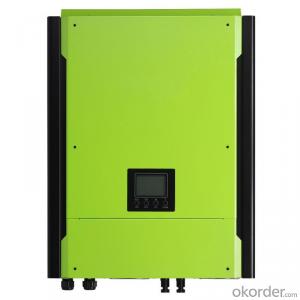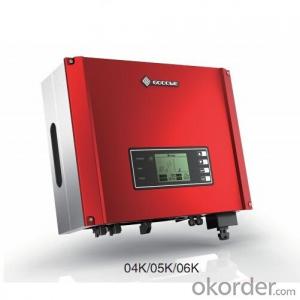Zamp Solar Inverter on Grid Solar Inverter .GW20K-DT
OKorder Service Pledge
OKorder Financial Service
You Might Also Like
GW17K-DT
GW20K-DT photovoltaic inverter is suitable for commercial and industrial roofs as well as small and medium-sized photovoltaic power systems.
Intelligent heat dissipation design ensures slower temperature rise and more stable running conditions.
The dual-lines MPPT extra-wide voltage range ensures that the system is with more flexible configuration.
Futures:
■ Maximum Efficiency up to 98.2%
■ 45℃ full-load output
■ European Efficiency up to 97.5%
■ Super large 5-inch LCD
■ MPPT Efficiency over 99.5%
■ 30% lighter than similar products
■ DC switch
■ Multiple monitoring and communication
■ IP65 dust-proof and water-proof rating
■ up to 800 pieces can be integrated in one system
Datasheet

- Q: Can a solar inverter be used with different types of backup power configurations?
- Yes, a solar inverter can be used with different types of backup power configurations. Solar inverters are designed to convert the direct current (DC) power generated by solar panels into alternating current (AC) power that can be used to power homes or businesses. They can be integrated with various backup power sources such as battery banks, diesel generators, or grid-connected systems. This flexibility allows for uninterrupted power supply during periods when solar energy is not available, ensuring continuous electricity supply.
- Q: How efficient are solar inverters?
- Solar inverters are highly efficient, typically converting around 95% to 98% of the direct current (DC) power generated by solar panels into usable alternating current (AC) electricity.
- Q: How does a solar inverter handle grid disturbances (voltage sags, swells, flickers)?
- A solar inverter handles grid disturbances such as voltage sags, swells, and flickers by constantly monitoring the grid's voltage and frequency. When a disturbance occurs, the inverter utilizes its internal control mechanisms to adjust the solar power output accordingly. It can compensate for voltage sags by injecting additional power into the grid, and it can reduce power output during voltage swells to prevent overloading. Additionally, the inverter's control algorithms help minimize flickering by maintaining a stable and consistent power supply to the grid.
- Q: What is the operating temperature range of a solar inverter?
- The operating temperature range of a solar inverter typically falls between -20°C to 50°C (-4°F to 122°F), although this can vary depending on the specific model and manufacturer.
- Q: What is the role of a maximum power point tracker (MPPT) in a solar inverter?
- The role of a maximum power point tracker (MPPT) in a solar inverter is to optimize the efficiency and power output of a solar panel system. Solar panels generate direct current (DC) electricity, but most appliances and the electrical grid operate on alternating current (AC). The MPPT is responsible for continuously adjusting the operating conditions of the solar panels to extract the maximum power available from the sunlight. It tracks the maximum power point (MPP) at which the solar panels can generate the most electricity efficiently. This is important because the output of a solar panel is highly dependent on factors such as temperature, shading, and the angle of the sun. By continuously monitoring and adjusting the voltage and current of the solar panel system, the MPPT ensures that the solar panels are always operating at the MPP, maximizing the power output. It achieves this by dynamically changing the electrical load on the solar panels to find the optimal operating point. The MPPT also acts as a converter, transforming the DC power generated by the solar panels into the AC power required for use by appliances or for feeding back into the electrical grid. This conversion process involves transforming the voltage and frequency of the electricity to match the requirements of the appliances or the grid. Overall, the role of a maximum power point tracker in a solar inverter is to optimize the efficiency and power output of the solar panel system, ensuring that the maximum amount of energy is harnessed from the sunlight and effectively utilized for various applications.
- Q: How does a solar inverter handle reverse power flow?
- A solar inverter handles reverse power flow by automatically adjusting its operation to convert and redirect excess electricity produced by the solar panels back into the grid. This process ensures efficient utilization of electricity and prevents any potential damage or overload to the solar system.
- Q: How do you calculate the power loss in a solar inverter?
- To calculate the power loss in a solar inverter, you need to subtract the output power from the input power. The input power can be determined by multiplying the input voltage and input current, while the output power is obtained by multiplying the output voltage and output current. Subtracting the output power from the input power will give you the power loss in the solar inverter.
- Q: What is the role of a solar inverter in reactive power control?
- The role of a solar inverter in reactive power control is to regulate and manage the flow of reactive power in a solar power system. It helps to maintain the power factor within an acceptable range, ensuring efficient and stable operation of the system. By adjusting the voltage and reactive power outputs, the solar inverter can compensate for any reactive power imbalances and maintain a balanced grid voltage. This helps to prevent power quality issues and ensures optimal performance and integration of solar energy into the grid.
- Q: In a photovoltaic grid-connected project, the role of the inverter is to convert the voltage into AC 220V or 380V for the grid, since the transformer will raise the voltage again
- Connected to the grid is connected to which specific location ah? Transformer is to buy a separate, or buy inverter inside the type of transformer? For example, Sweden's 15KW and 30KW grid roof projects, the roof, for example, more remote to be transported to other electricity.
- Q: How does a solar inverter handle excess power production?
- A solar inverter handles excess power production by redirecting the surplus energy back into the grid or storing it in batteries for later use.
Send your message to us
Zamp Solar Inverter on Grid Solar Inverter .GW20K-DT
OKorder Service Pledge
OKorder Financial Service
Similar products
Hot products
Hot Searches
Related keywords























